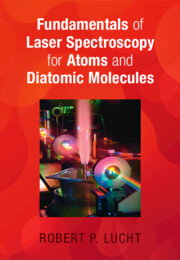Book contents
- Frontmatter
- Dedication
- Contents
- Preface
- 1 Introduction
- 2 Atomic Structure and the Quantum Mechanics of Angular Momentum
- 3 Structure of Diatomic Molecules
- 4 Quantum Mechanical Analysis of the Interaction of Laser Radiation with Electric Dipole Resonances
- 5 Quantum Mechanical Analysis of Single-Photon Electric Dipole Resonances for Diatomic Molecules
- 6 Absorption and Emission Spectroscopy
- 7 Raman Spectroscopy
- 8 Coherent Anti-Stokes Raman Scattering (CARS) Spectroscopy
- Spherical Harmonics and Radial Wavefunctions for One-Electron Atoms
- Clebsch–Gordan Coefficients, Dipole Moments, and Spontaneous Emission Coefficients for the 2p–1s Transition in Atomic Hydrogen
- Properties and Values for Selected 3j Symbols
- Properties and Values for Selected 6j Symbols (Weissbluth, 1978)
- Allowed LS Coupling Terms for Equivalent d2 Electrons
- Derivation of the Higher-Order Density Matrix Elements for Doublet and Triplet Electronic Levels
- Einstein Coefficients for Spontaneous Emission for the X2Π–A2Σ+ (0,0) Bands of OH and NO and the X3Σ−–A3Π (0,0) Band of NH
- Effect of Hyperfine Splitting on Radiative Transition Rates
- Voigt Function Values
- References
- Index
4 - Quantum Mechanical Analysis of the Interaction of Laser Radiation with Electric Dipole Resonances
Published online by Cambridge University Press: 12 December 2024
- Frontmatter
- Dedication
- Contents
- Preface
- 1 Introduction
- 2 Atomic Structure and the Quantum Mechanics of Angular Momentum
- 3 Structure of Diatomic Molecules
- 4 Quantum Mechanical Analysis of the Interaction of Laser Radiation with Electric Dipole Resonances
- 5 Quantum Mechanical Analysis of Single-Photon Electric Dipole Resonances for Diatomic Molecules
- 6 Absorption and Emission Spectroscopy
- 7 Raman Spectroscopy
- 8 Coherent Anti-Stokes Raman Scattering (CARS) Spectroscopy
- Spherical Harmonics and Radial Wavefunctions for One-Electron Atoms
- Clebsch–Gordan Coefficients, Dipole Moments, and Spontaneous Emission Coefficients for the 2p–1s Transition in Atomic Hydrogen
- Properties and Values for Selected 3j Symbols
- Properties and Values for Selected 6j Symbols (Weissbluth, 1978)
- Allowed LS Coupling Terms for Equivalent d2 Electrons
- Derivation of the Higher-Order Density Matrix Elements for Doublet and Triplet Electronic Levels
- Einstein Coefficients for Spontaneous Emission for the X2Π–A2Σ+ (0,0) Bands of OH and NO and the X3Σ−–A3Π (0,0) Band of NH
- Effect of Hyperfine Splitting on Radiative Transition Rates
- Voigt Function Values
- References
- Index
Summary
The subject of this chapter is the quantum mechanical analysis of the interaction of electromagnetic radiation with atomic transitions. The analysis is based on the Schrödinger wave equation, and in the first section, the gauge-invariant form of the external electromagnetic field is introduced. The electric dipole interaction and the long-wavelength approximation for the analysis of this interaction are discussed. The perturbative analysis of both single-photon and two-photon electric dipole interactions is presented, and density matrix analysis is introduced. The interaction of radiation with the resonances of atomic hydrogen is then discussed. The analysis is performed for both coupled and uncoupled representations. In the last section of the chapter, the radiative interactions for multielectron atoms are discussed. The Wigner–Eckart theorem and selection rules for transitions between levels characterized by coupling are developed. The effect of hyperfine splitting on radiative transitions is also briefly discussed.
Keywords
- Type
- Chapter
- Information
- Publisher: Cambridge University PressPrint publication year: 2024

